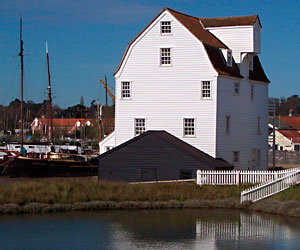Suffolk Watermills
Suffolk watermills were much scarcer than the windmills due to a lack of suitable rivers, only about 100 standing during the 19th. century, but because they were larger than many of the windmills a higher proportion has survived. Over 50 watermills remain, of which about a third are complete with their machinery.
The use of water power in this country goes back to Roman times but firm evidence is lacking as to when they came into common use locally. It is possible that from the mid 7th century at least watermills were being erected and by the time of the “Domesday” survey 178 mills (believed to have all been watermills) are recorded. This number is probably overstated slightly due to a set of millstones being counted as one mill, so a building with two or more sets might be counted as 2 or more mills. At this date all the mills would have been for corn milling.
With the rise of the cloth industry in the centuries following the conquest water powered fulling mills were built, sometimes on the site of corn mills and sometimes next to them. By the 16th century the number of watermills in Suffolk had probably reached its peak; my guess at the total would be in the order of 200. Many sites were on little more than ditches, with water having to be impounded for a considerable period before being able to work. The more marginal sites were abandoned until the early 19th century when numbers stabilised. With the loss of the cloth industry fulling mills disappeared but in the early 19th. century Suffolk could boast water-powered “mills” for silk throwsting, papermaking, oil manufacture, flax spinning and possibly scutching, water pumping, cement grinding and one for “oil leather dressing, glue boiling and fell mongering” as well as more commonplace corn milling.
Due to the relatively low fall available on most Suffolk rivers most mills used undershot or low-breastshot wheels. Some overshot and high-breastshot wheels were to be found, usually on smaller tributaries but even at these a head of 10 feet was the usual limit. In the late 19th. century some larger mills replaced their wheels with more efficient water turbines. There are no records of “horizontal” wheels in Suffolk such as those found in other parts of the British Isles but it is quite possible that the earliest mills could have used this kind of wheel, which required no gearing and so was easier to make.
Tide mills were found on the larger estuaries; one at Ipswich and the well-known Woodbridge mill were true tide mills, relying totally on impounded salt water and there were others at Ipswich, Stutton, and Brantham which used impounded salt water as well as having freshwater streams or rivers running into them.

All other Suffolk watermills
For a comprehensive list of Suffolk watermill sites click here. You will see which sites still have mill remains and where possible there is a link to a historic photograph.
This part of the website is still a work in progress ad there will be more photographs being added all the time.
